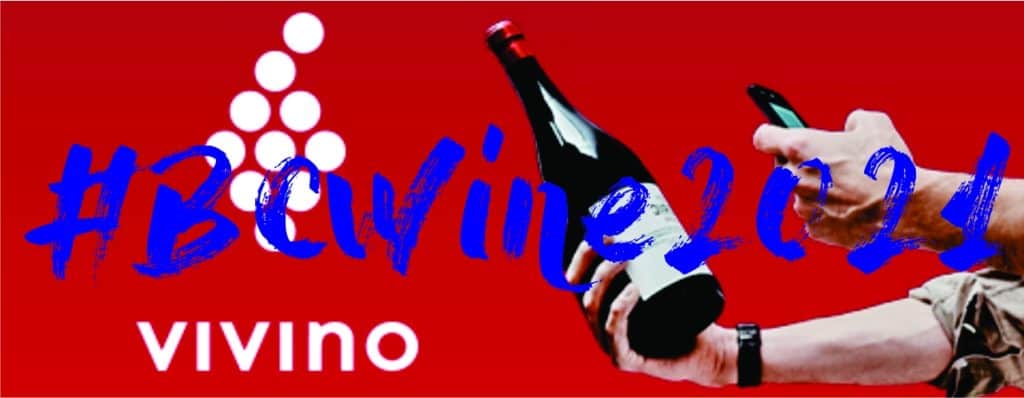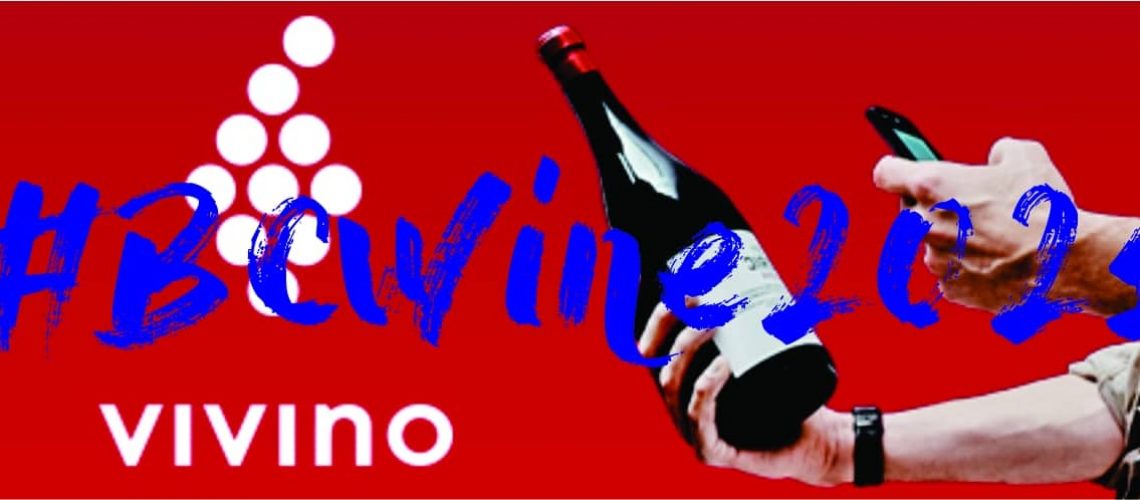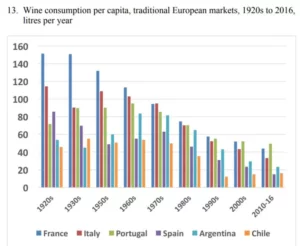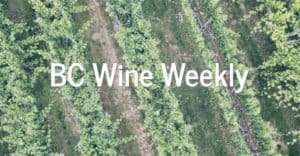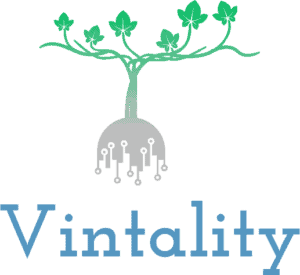We’re hosting a webinar April 4th on #BCWineData2021.
Following on from last year’s edition, Paul has constructed a vast database on BC Wine and its competitive position. He’ll be demonstrating an interactive version of this year’s report that can respond to your specific needs for analysis and information on BC Wine by history, market share, region, wine type, scores, pricing, channel, competitiveness against imports and much, much more. This introductory session will demonstrate the scope of the project and how every winery, regardless of size, can leverage the analysis to craft better product positioning and improve sales.
April 4th, Monday, 9:30 a.m. – 10:30 a.m.
REGISTER HERE
There are many rating services and competitions. Some carry higher influence than others either internationally, nationally, or locally – each has a merit and an audience. Wineries need to pick those that are most relevant as there are both time and money costs incurred by the winery. Crowd-sourced scores are widely distributed and can be leveraged with very little investment of time.
Vivino is the largest international crowd-sourced scoring app and the one, from observation, that is the most used by all levels of BC consumers[i] at point of purchase. Vivino’s primary overall score[ii] is a compound average based on total results over time and is the first data point on the screen when searching – many do not go beyond this. I have matched up over 3,000 Vivino scores against BC and import wines sold in BC.
BC wines have garnered substantial market share here in the Province and at premium pricing versus import competition. Vivino says that the average score across its database is about 3.6. With over 1,900 BC wine scores added to the database – accounting for about 75% of BC wine litre volume sold in 2021, 83% of BC wines rate higher than average! And, more importantly, in BC wine’s key volume, price and variety segments it consistently scores higher than comparable imports sold here.

Vivino has some added advantages
- Exporters: I was on the Small Business BC Wine Export Seminar on February 24 this year. It was pointed out that Canadian competitions and ratings do not carry much weight outside of Canada and not to rely on them in international marketing. Vivino scores are global so an app user anywhere in the world can see scores on Canadian wines.
- Visitors to BC or to winery website from outside of Province: While there are many score sites for wineries (e.g., TripAdvisor) as we have seen recently these can be manipulated. Vivino scores are much less susceptible to malicious attack or gaming. Given Vivino’s global presence there is much more likelihood of these visitors contributing a useful score. Also, out-of-Province visitors are less likely to read or use local score services.
- Comparative Scores to a wide range of wines: Vivino scores have the added benefit of providing a common basis to compare BC with import wines. Consumers can easily look up a wine by simply snapping a photo of the label.
- Scores are persistent: Scores exist long after everyone forgets what award was won in 2021. Consumers in 2022 are not going to hunt around for past Awards. This is not a unique Vivino advantage but highlights that Awards are vintage specific and, unless constantly and consistently promoted, have a very limited shelf life for the consumer.
Do Consumers agree with Judges? Overall, they do
One aspect I wanted to explore was whether winners of judged awards differed significantly from crowd-sourced scores.
WineAlign is Canada’s biggest national competition. It draws in a wide pool of judges and is based on blind tasting. Judges include several people who have popular score sites. I have used only Platinum, Gold and Silver levels as these provide the most winery marketing[iii] pay-off. 46 of the award-winning wines have no Vivino score as yet. The table below compares only those 305 that have a match.
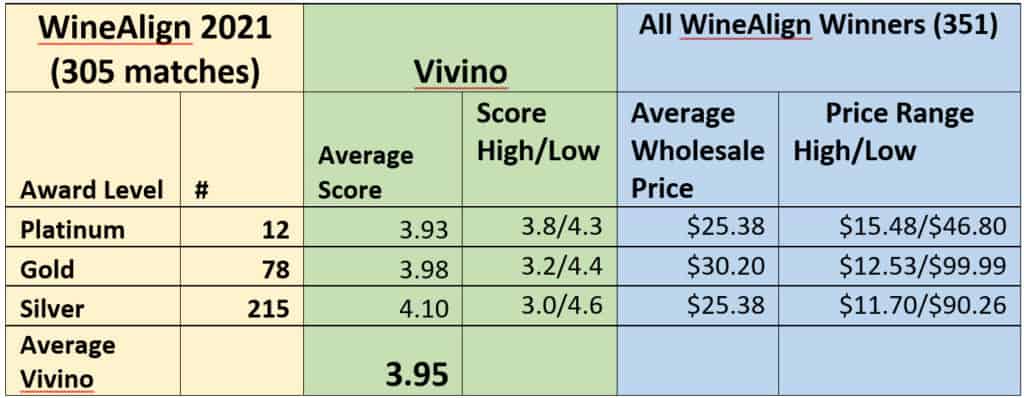
The overall average Vivino score generally supports the judges as it is higher than the BC average. However, there are some significant variations within each level of award. Judges and consumers are quite aligned at the Platinum level with a small spread of Vivino scores. Silver represents the largest divergence. The difference in scores within the award levels is possibly the result of comparing a specific vintage to an accumulated score. Awards can be considered as “Lead Indicators” compared to Vivino scores.
One of the major benefits of blind tasting is that price is not a factor in judging. While the average for award winners is well above that of BC overall, there are value gems in each tier at very reasonable prices. Vivino scores show a moderate positive correlation of score to price.
WineAlign Platinum and Gold award winners tend to be low volume, boutique wines. Silver winners had a significantly higher average volume. This higher volume means they have a wider range of consumers which in turn creates a broader range of scores. The total 351 WineAlign award winning wines account for about 10% of BC wine’s overall sales in 2021. Two thirds of these sold less than 500 cases and are <2% of BC’s 2021 wine volume.
WineAlign publishes its point counts for the award winners on its website. The underlying points for the award winners on the WineAlign site also share with Vivino a range of scores, generally 93+ for Platinum, 91-93 for Gold, 89-92 for Silver so the awards are not entirely driven by their scoring methodology.
“Action this Day” – Winston Churchill – What can a winery do?
- Add a “Rate Us on Vivino” sign in your tasting room AND on your website
Encourage consumers to rate your wine on Vivino. The number people scoring your wine is important as a high score with a very low number of ratings is nowhere near as compelling as one with many. There are wines in the Vivino database with tens of thousands of ratings. A good starting goal is to get at least 100 ratings per product. - Promote the scores at your point of sale and marketing materials
Vivino scores are another part of your marketing toolkit just like awards and ratings from other sources. Vivino scores at 4.0 or greater need to be highlighted.
As a general observation, wineries are not proactive enough in communicating awards and scores of any sort either directly or through their agent salesforce to channel partners. More significantly, wineries are also not taking advantage of any awards or ratings at the key point of purchase on their websites –the “shop wine” section should have every wine with an award or useful score highlighted or badged in some way. - Leverage Awards to raise low scores
Wineries who have award winners but low Vivino scores can encourage better ratings by adding a ‘badge’ or other call out at the very least to the “shop wine” section on their website to amplify the positive news. For instance, the Silver award wine that scored 3.0 on Vivino (that’s like scoring 70 on the hundred point scale but perhaps it was just not one of their best years) should be heavily promoting its award and making sure that its channel partners are informed on how to communicate this contradictory data to consumers. This wine only has 14 ratings so a few additions of better scores will rapidly pull it up from the basement. However, if you already have hundreds of ratings and a low score this might not be as easy to overcome. This a useful example of how awards and ratings can interact with each other – not every vintage wins “Platinum”
There’s a lot more to come on Vivino scores in the #BCWine2021 data including score comparisons between BC wines and import wines by price segment and by variety as sold.
[i] Vivino claims over 50M subscribers worldwide
[ii] On Vivino, consumers rate wines in a scale of 5 (best). Historically scores were allowed in 0.5 increments (e.g., 3, 3.5,4.0 etc.) – all the scores analysed above used this scale. However, in March 2022 Vivino changed its score scale to 0.1 increments so that users can now rate a wine say, at 3.7 versus having to choose between 3.5 and 4.0. Over time this will refine scores but their database has a tremendous inertia built on the previous scale so there will be no immediate rescore of any past score by this change unless the number of scores is very low.
[iii] Judges can only taste what is submitted to competition so there is an inbuilt selection bias as wineries tend to submit their “best” wines, understandably. Apart from any marketing benefit of awards, wineries use the results to calibrate their own wines against the market.

